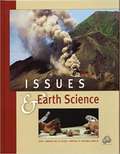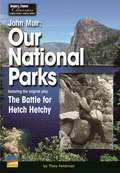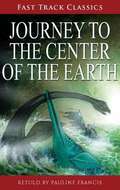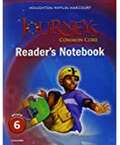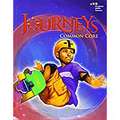- Table View
- List View
More NIMAC books are available at www.nimac.us. If you find your title in the NIMAC and not in Bookshare then please contact us to request it.
Issues and Physical Science: Waves, Revised
by University of California Berkeley Lawrence Hall of ScienceNIMAC-sourced textbook <p>How are waves both helpful and harmful? Students encounter a variety of technologies that make use of waves. They also investigate the harmful effects of certain waves and methods to mitigate the risks associated with these waves. PE Assessment Example: Use what you learned from your hands-on investigation to explain why noise is more of a problem for analog vs digital signals, and why digital signals are more reliable to encode and transmit information. Waves is part of Issues and Science three year middle school program, designed by SEPUP at the Lawrence Hall of Science. This five week unit anchors the lessons around the the socio-science issue: How are waves both helpful and harmful? Investigative phenomena within the 15 activities connect back to the issue and storyline. This unit builds towards and assesses PEs PS4-1, PS4-2, PS4-3. The Student Book guides students in exploring a socio-science issue and connected phemonena through a series of varied activity types. Activity types use one of twelve different instructional strategies to apply Science and Engineering Practices to specific Disciplinary Core Ideas and Cross Cutting Concepts. SEPUP's integrated literacy strategies help students process new science content, develop their analytical skills, make connections between related concepts, and express their knowledge orally and in writing. The built-in assessment system helps teachers identify students' strengths and weaknesses from the beginning of the unit. This allows them to adjust activities when needed so that all students get the best chance to build their knowledge and appreciation of science. At the back of the Student Book there is an Appendix containing additional resources for students, such as science skills, literacy strategies, and media literacy among others. </p>
Issues and Physical Science: Force and Motion, Revised
by University of California at Berkeley Lawrence Hall of ScienceNIMAC-sourced textbook
Issues and Physical Science: Fields and Interactions, Revised
by University of California at Berkeley Lawrence Hall of ScienceNIMAC-sourced textbook <p>Fields and Interactions is part of Issues and Science three year middle school program, designed by SEPUP at the Lawrence Hall of Science. This five week unit anchors the lessons around the the socio-science issue: How do different types of force fields help us design transportation? This unit builds towards and assesses PEs PS2-3, PS2-4, PS2-5, PS3-2, ETS1-1, ETS1-2. The Student Book guides students in exploring a socio-science issue and connected phemonena through a series of varied activity types. Activity types use one of twelve different instructional strategies to apply Science and Engineering Practices to specific Disciplinary Core Ideas and Cross Cutting Concepts. SEPUP's integrated literacy strategies help students process new science content, develop their analytical skills, make connections between related concepts, and express their knowledge orally and in writing. The built-in assessment system helps teachers identify students' strengths and weaknesses from the beginning of the unit. This allows them to adjust activities when needed so that all students get the best chance to build their knowledge and appreciation of science. At the back of the Student Book there is an Appendix containing additional resources for students, such as science skills, literacy strategies, and media literacy among others.</p>
Issues and Physical Science: Energy, Revised
by University of California at Berkeley Lawrence Hall of ScienceNIMAC-sourced textbook <p>How can people manipulate energy transfer and transformation to use energy more efficiently? Students learn about the transfer and transformation of energy in their everyday lives. They plan and carry out investigations and analyze and interpret data from experiments to investigate how energy is transferred and transformed. They also engage in engineering challenges to design and test devices to maximize and minimize energy transfer. PE Assessment Example: Design, test, evaluate, and redesign a solar oven that maximizes thermal energy transfer. Energy is part of Issues and Science three year middle school program, designed by SEPUP at the Lawrence Hall of Science. This six week unit anchors the lessons around the the socio-science issue: How can people manipulate energy transfer and transformation to use energy more efficiently? Investigative phenomena within the 15 activities connect back to the issue and storyline. This unit builds towards and assesses PEs PS3-3, PS3-4, PS3-5, MS-ETS1-4. The Student Book guides students in exploring a socio-science issue and connected phemonena through a series of varied activity types. Activity types use one of twelve different instructional strategies to apply Science and Engineering Practices to specific Disciplinary Core Ideas and Cross Cutting Concepts. SEPUP's integrated literacy strategies help students process new science content, develop their analytical skills, make connections between related concepts, and express their knowledge orally and in writing. The built-in assessment system helps teachers identify students' strengths and weaknesses from the beginning of the unit. This allows them to adjust activities when needed so that all students get the best chance to build their knowledge and appreciation of science. At the back of the Student Book there is an Appendix containing additional resources for students, such as science skills, literacy strategies, and media literacy among others.</p>
Issues and Physical Science: Chemistry of Materials, Revised
by University of California at Berkeley Lawrence Hall of ScienceNIMAC-sourced textbook <p>How do people use chemical reactions to solve problems? Students analyze and interpret data to determine whether chemical reactions have taken place. They use models to explain what takes place at the atomic/molecular scale during a reaction. They also apply what they learn about chemical reactions to such problems as designing useful products and identifying processes for cleaning up chemical wastes. PE Assessment Example: Use the reaction you have just studied to design, test, and modify a device that can be used as a handwarmer. Chemical Reactions is part of Issues and Science three year middle school program, designed by SEPUP at the Lawrence Hall of Science. This three week unit anchors the lessons around the the socio-science issue: How do people use chemical reactions to solve problems? Investigative phenomena within the 13 activities connect back to the issue and storyline. This unit builds towards and assesses PEs PS1-2, PS1-5, PS1-6. The Student Book guides students in exploring a socio-science issue and connected phemonena through a series of varied activity types. Activity types use one of twelve different instructional strategies to apply Science and Engineering Practices to specific Disciplinary Core Ideas and Cross Cutting Concepts. SEPUP's integrated literacy strategies help students process new science content, develop their analytical skills, make connections between related concepts, and express their knowledge orally and in writing. The built-in assessment system helps teachers identify students' strengths and weaknesses from the beginning of the unit. This allows them to adjust activities when needed so that all students get the best chance to build their knowledge and appreciation of science. At the back of the Student Book there is an Appendix containing additional resources for students, such as science skills, literacy strategies, and media literacy among others.</p>
Issues and Physical Science: Chemical Reactions, Revised
by University of California at Berkeley Lawrence Hall of ScienceNIMAC-sourced textbook <p>How do people use chemical reactions to solve problems? Students analyze and interpret data to determine whether chemical reactions have taken place. They use models to explain what takes place at the atomic/molecular scale during a reaction. They also apply what they learn about chemical reactions to such problems as designing useful products and identifying processes for cleaning up chemical wastes. PE Assessment Example: Use the reaction you have just studied to design, test, and modify a device that can be used as a handwarmer. Chemical Reactions is part of Issues and Science three year middle school program, designed by SEPUP at the Lawrence Hall of Science. This three week unit anchors the lessons around the the socio-science issue: How do people use chemical reactions to solve problems? Investigative phenomena within the 13 activities connect back to the issue and storyline. This unit builds towards and assesses PEs PS1-2, PS1-5, PS1-6. The Student Book guides students in exploring a socio-science issue and connected phemonena through a series of varied activity types. Activity types use one of twelve different instructional strategies to apply Science and Engineering Practices to specific Disciplinary Core Ideas and Cross Cutting Concepts. SEPUP's integrated literacy strategies help students process new science content, develop their analytical skills, make connections between related concepts, and express their knowledge orally and in writing. The built-in assessment system helps teachers identify students' strengths and weaknesses from the beginning of the unit. This allows them to adjust activities when needed so that all students get the best chance to build their knowledge and appreciation of science. At the back of the Student Book there is an Appendix containing additional resources for students, such as science skills, literacy strategies, and media literacy among others.</p>
Issues and Physical Science: Energy
by University of California at Berkeley Lawrence Hall of ScienceNIMAC-sourced textbook
Issues & Earth Science
by University of California at Berkeley Lawrence Hall of ScienceNIMAC-sourced textbook
Issues & Life Science
by University of California at Berkeley Lawrence Hall of ScienceNIMAC-sourced textbook
Jake Digs a Hole; Luke and the Bug Man: Set of 6 (Readers' and Writers' Genre Workshop Ser.)
by Dina Anastasio Amanda Jenkins Lyn Boyer Shawn ByousNIMAC-sourced textbook
Jam Sandwich (Fountas & Pinnell Classroom, Guided Reading Grade 6)
by Kari Holt Philippe LechienNIMAC-sourced textbook
The Jewel Heist (Fountas & Pinnell Classroom, Guided Reading)
by Teri Eastman Tony ShasteenNIMAC-sourced textbook
John Muir: Featuring the Original Play, The Battle for Hetch Hetchy (Readers Theater Classics)
by Thea FeldmanNIMAC-sourced textbook
The Journal of James Edmond Pease: The Journal Of James Edmond Pease, A Civil War Union Soldier
by Jim MurphyNIMAC-sourced textbook
Journey to the Center of the Earth: Mandarin Companion Graded Readers: Level 2, Traditional Chinese Edition (Foundation Classics Ser.)
by Pauline Francis Jules Verne Gary AndrewsNIMAC-sourced textbook
Journeys, Grade 6, Close Reader: Close Reader Grade 6 (Journeys Ser.)
by Houghton Mifflin HarcourtNIMAC-sourced textbook
Journeys [Grade 6], Common Core
by James F. Baumann David J. Chard Jamal CooksNIMAC-sourced textbook
Journeys, Grade 6, Reader's Notebook: Reader's Notebook Grade 6 (Journeys)
by Houghton Mifflin HarcourtNIMAC-sourced textbook
Journeys in Literature and Nonfiction Grade 6
by Tim MansfieldNIMAC-sourced textbook <p>Grade 6</p>

